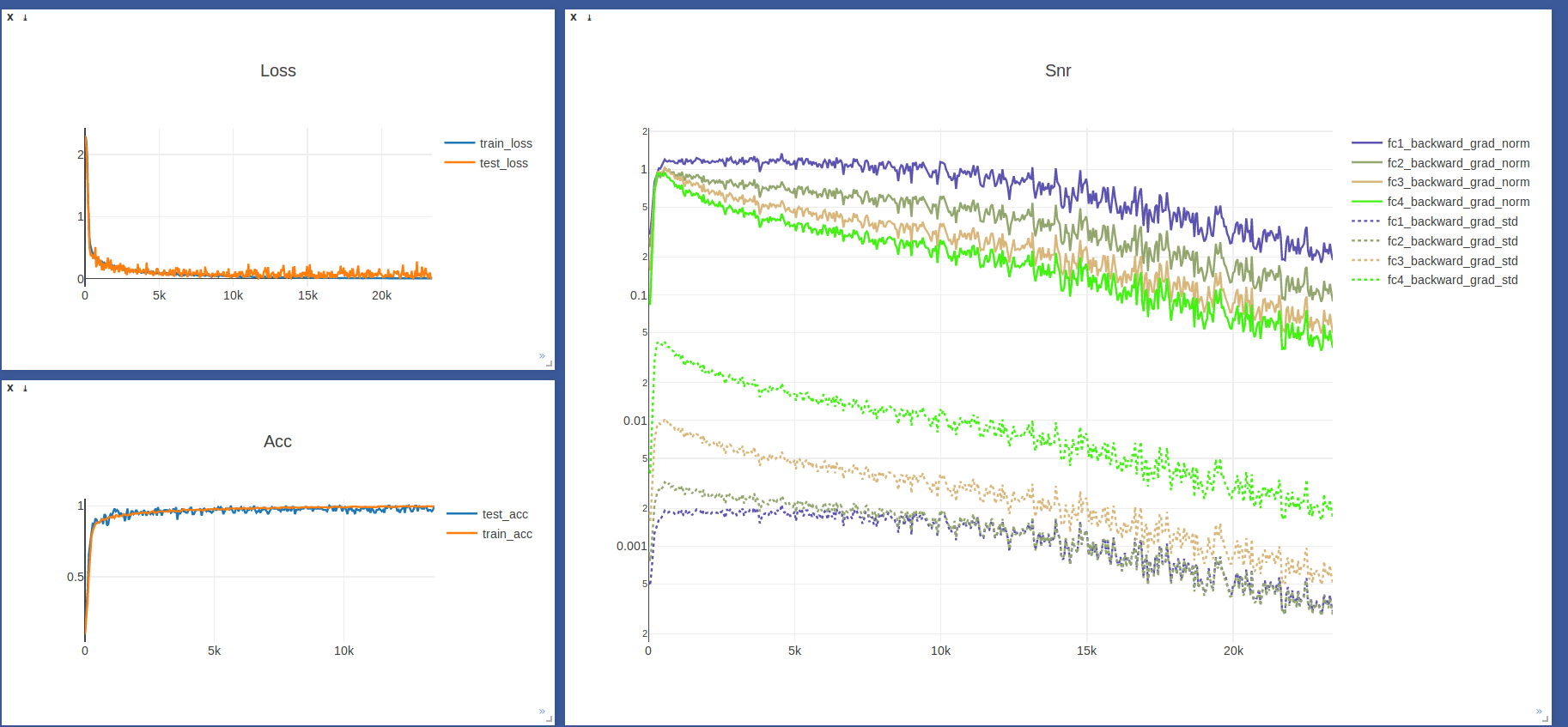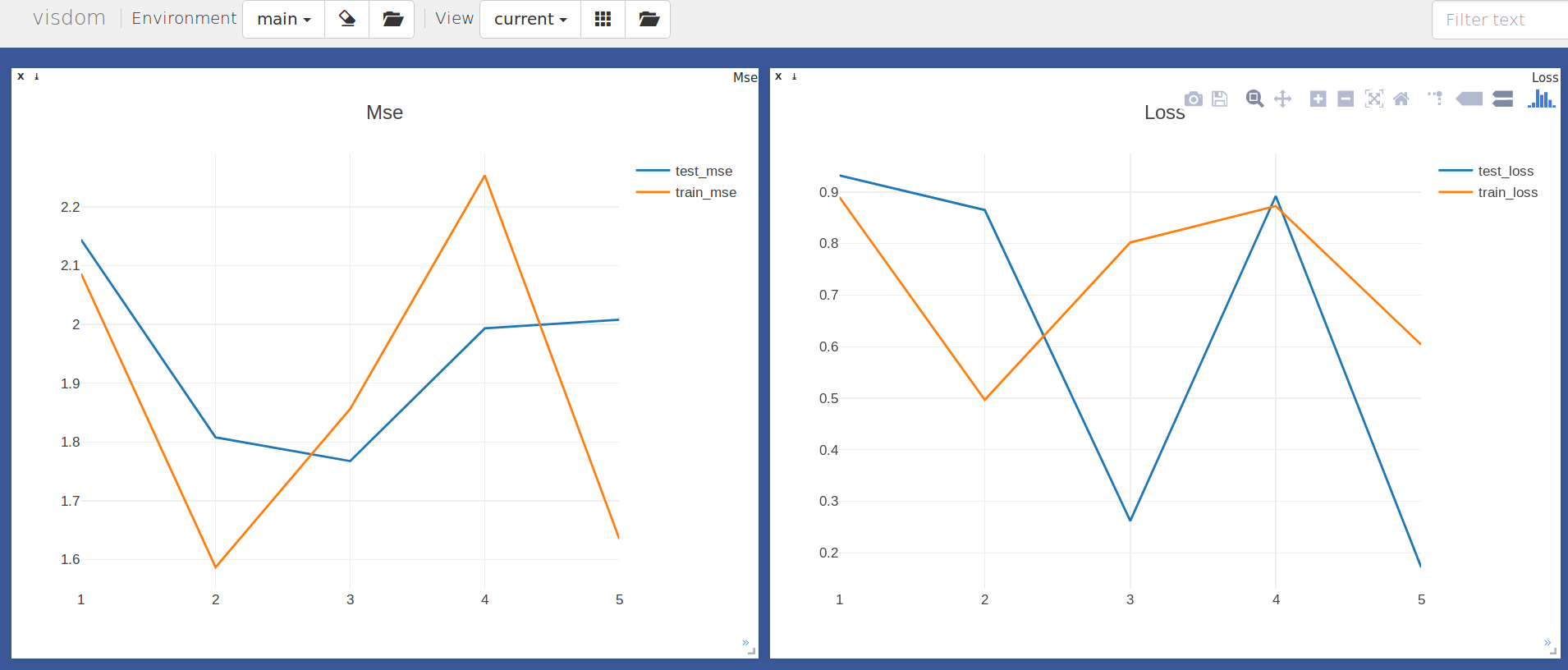A utility for visdom metering and logging built on top of TNT, and some utlities for recording model status during training. The idea is to provide a declarative way to generate meters and loggers with a clean api. But isn'y pytorch all about nondeclarative style? Well I find the imperative pythonic expirience useful for stuff where I need to expirement, not for the stuff that I know and just need to make go.
Or maybe it would be good to just have some common debugging things, and have a way to build plots like mutual information loss readily available. Anyway, the meters and loggers are contained in a single object, which is updated by dictionaries of values.
Api for preset configurations (somewhat inspired by Cadene's pretrainedmodels). Adding and logging data uses same api as TNT visdom logger (add, log, reset)
from pytorchart import FlexLogger
# quick way to create a logger object
Stat = FlexLogger.from_presets('loss', 'mse')
# print out the plots and meters providing their data
Stat.get_definitions()
>>> {'loss': ['train_loss', 'test_loss'],
'mse': ['train_mse', 'test_mse']}
# ADDING DATA
# log stuff one by one as dict of keys
Stat.add({'train_mse': [torch.randn([4, 20]), torch.randn([4, 20])]})
# call method defaults to adding with keyword
Stat.add(test_mse=[torch.randn([4, 20]), torch.randn([4, 20])])
# call takes multiple keys as long as they exist
Stat(train_loss=0.7, test_loss=0.7) # or log several keys at once
# TRAINING PROCESS
# usually, in training it goes something like
output = model(data)
loss = criterion(target, output)
loss.backward()
optimizer.step()
# FlexLogger tracks its own step counter (or you can add a hook)
Stat.step() # simple update of internal counter
# or log all the keys with the None option, and reset the meters by default.
Stat.log() # plots the data in all meters to respective plots
Stat.reset() # resets meters
# log takes some keyward args to reset the meters, and to add a step as well
# keys can be used to log/reset etc meters with only some keys
Stat.log(reset=True, step=True, keys=['train_mse', 'test_mse'])
Stat = FlexLogger.from_presets('loss', 'mse')
for i in range(5): # do a loop
Stat(train_loss=random.random(), test_loss=random.random()])
Stat(**{k: [torch.randn(4, 20), torch.randn(4, 20)] for k in ['test_mse', 'train_mse']})
Stat.log(step=True, reset=True)
Defining custom configured loggers is done with dictionaries, and visdom kwargs. These are a bit clunky, but I tend to put my definitions in a file somewhere and reuse all over the place...
Stat = flexlogger.FlexLogger(
{'loss': {'type': 'line'}
'images': {'type': 'image', opts': {'env': 'my_env2'}}}
{'train_loss': {'type': 'AverageValueMeter', 'target': 'loss'},
'test_loss': {'type': 'AverageValueMeter', 'target': 'loss'} }
env='my_env', uid='my_uid')
The TooledModel module registers hooks for recording gradients and model weights during training When pytorch 1 comes out, will need to add profiling to it maybe.
inputs, targets = Variable(torch.rand(2, 20)), Variable(torch.rand(2, 3))
model = nn.Sequential(nn.Linear(20, 10), nn.Linear(10, 3))
# Tooling object registers
TM = TooledModel(model)
output = model(inputs)
loss = F.mse_loss(output, targets)
loss.backward()
# print a table
TM.table()
>>> +----------+------------------+------------------+------------------+------------------+
| | Grad_in | Grad_out | Inputs | Weights |
| Layers | mean std | mean std | mean std | mean std |
+----------+------------------+------------------+------------------+------------------+
| 0 | 0.0287 0.0068 | 0.0287 0.0068 | 0.2769 0.4568 | 0.1318 -0.0042 |
| 1 | 0.0519 -0.0658 | 0.0519 -0.0658 | 0.2946 -0.0271 | 0.1878 -0.0139 |
+----------+------------------+------------------+------------------+------------------+
# or return the dictionary of values for whatever:
TM.table()
The TooledModelLogger class creates a ModelLogger, and then send that to a FlexiLogger. TooledMOdelLogger has same APIs, (log, reset, add) with the addition of step. For now, every time you want to move data, you should call TooledModelLogger.step(). I will play around a bit on how this wants to be configured and initialized, but for now TML will create a chart for each layer or for each metric.
from src.modellogger import TooledModelLogger
model = nn.Sequential(nn.Linear(20, 10), nn.Linear(10, 3))
optim = torch.optim.Adam(model.parameters())
TMLogger = TooledModelLogger(model)
for i in range(4):
inputs = Variable(torch.rand(2, 20))
targets = Variable(torch.rand(2, 3))
outputs = model(inputs)
(F.mse_loss(outputs, targets)).backward()
optim.step()
# call step to iterate its step counter, and send data to loggers.
# log indicates to flush the Loggers into their plots
TMLogger.step(log=True)
Results in:
See examples file for mnist example, and the unittests for options on plot inits. Really I think my goal is to have these config files for common tasks that work across all my models (like tensorboard, but with control over enviornments and customization )
If you are not a fan of dictionaries for your data during expirements, this may not be for you. I tend to like not redoing my logging creation functions for every expriment, so I decided to consolidate these. If you like tnt's MeterLogger, but also like logging random things like histograms of your weights, this may be for you.
todo setup.py
pip install visdom
pip install --upgrade git+https://github.com/psavine42/flexilogger.git@master
-
adding plots on the fly:
Stat.add_plot() Stat.add_meter() Stat.update_defintion()
-
is it worth having modes instead of explicit settings for each logger? Probably not ... Sine config is declarative as it is, it does not need any utility.
-
Pass in Klass instead of string?
-
more tests
-
decide which config layout to use.
-
visdom seriazliation tools for test_check
-
do something


